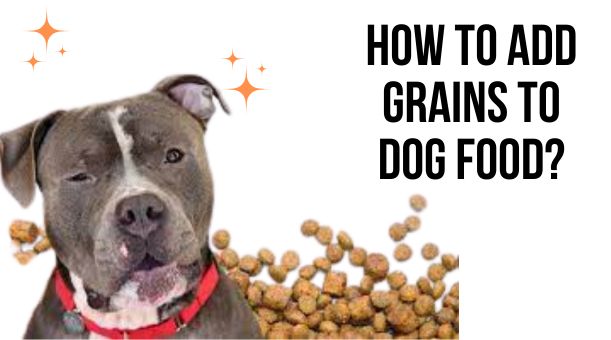Adding grains to your dog’s food is a topic of much debate among pet owners. While some argue that dogs do not need grains in their diet, others believe that adding grains can be a beneficial source of nutrition.
In this article, we will explore adding grains to dog food in-depth, answering common questions and concerns that pet owners may have.
Whether you are considering adding grains to your dog’s diet or want to learn more about this topic, this article will provide valuable information and insights.
What are grains, and why are they important in dog food?
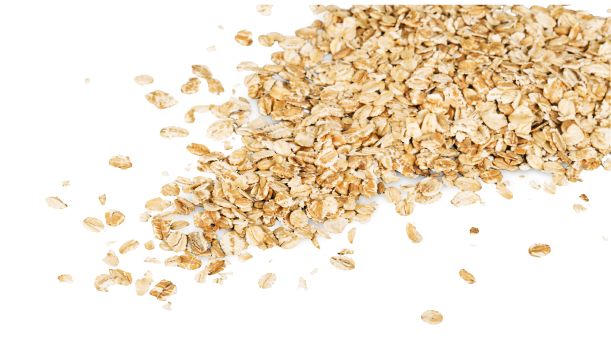
Grains are a group of small, hard, and edible seeds that come from cereal crops. Grains commonly found in dog food include wheat, rice, barley, and oats. Grains are an important source of carbohydrates, fiber, and essential nutrients such as vitamins and minerals.
They also provide energy and can aid in digestion. While dogs can survive on a diet free of grains, including grains in their food can provide various health benefits, especially when combined with other nutritious ingredients.
However, it’s important to note that not all grains are safe or suitable for all dogs, and some dogs may have allergies or sensitivities to certain grains.
Importance:
- Grains are a valuable source of carbohydrates, fiber, and essential nutrients in dog food.
- Carbohydrates from grains provide energy for dogs to stay active and maintain healthy bodily functions.
- Fiber from grains can aid digestion, regulate bowel movements, and support overall gut health.
- Grains contain essential nutrients such as vitamins and minerals for a balanced diet.
- Adding grains to a dog’s food can also help keep them full and satisfied, aiding in weight management.
However, it’s important to choose safe and appropriate grains for your dog’s needs and ensure that grains are not the main source of protein in your dog’s diet.
Which grains are safe for dogs to eat?
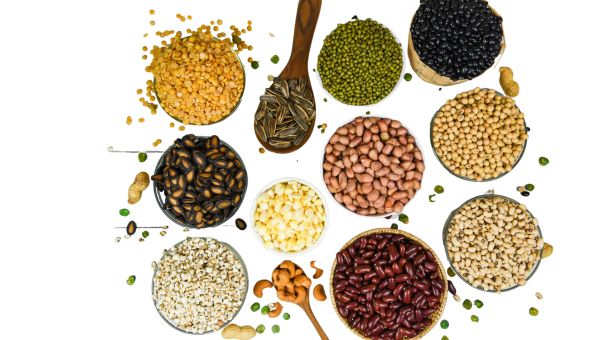
Many grains are safe for dogs, but some may be better suited for dogs than others. Here are some of the most commonly used grains in dog food that are generally considered safe:
- Brown rice
- Oats
- Quinoa
- Barley
- Millet
- Buckwheat
- Whole wheat
- Whole corn
It’s important to note that some dogs may have allergies or sensitivities to certain grains, just like some humans do. In addition, not all grains are suitable for all dogs. For example, dogs with certain health conditions, such as diabetes or obesity, may require a low-carbohydrate diet that limits the number of grains they consume. Therefore, it’s best to consult your veterinarian to determine which grains are safe and appropriate for your dog’s needs.
How to add grains to dog food?
There are several ways to add grains to your dog’s food. Here are some options:
Mix in cooked grains
Cooked grains such as rice or quinoa can be mixed with your dog’s food. Start by adding a small amount and gradually increase the amount over time.
Use a grain-inclusive dog food
Many commercial dog foods contain grains as a primary ingredient. Look for high-quality dog food brands that use whole grains and do not include fillers or artificial preservatives.
Make homemade dog food with grains
If you prefer to make your dog food, many homemade dog food recipes include grains. However, ensuring the recipe is balanced and meets your dog’s nutritional needs is important.
Add a grain supplement
If you prefer to feed your dog a grain-free diet but want to add the benefits of grains, you can use a grain supplement. These supplements, such as powders or capsules, come in various forms and can be mixed with your dog’s food.
Remember to introduce new food slowly and monitor your dog for signs of digestive upset or allergic reactions. It’s also important to consult with your veterinarian before significantly changing your dog’s diet.
How many grains should I add to my dog’s food?
The amount of grains to add to your dog’s food depends on various factors, such as age, size, activity level, and overall health. Generally, grains should comprise at most 50% of your dog’s diet. However, this percentage may be lower for dogs that require a low-carbohydrate or grain-free diet due to health issues.
When adding grains to your dog’s diet, start with a small amount and gradually increase the portion over several days to avoid digestive upset. You can also consult your veterinarian or a veterinary nutritionist to determine the appropriate amount of grains for your dog’s needs.
Remember that while grains can provide many health benefits, they should not be the primary source of protein in your dog’s diet. Dogs are carnivores and require a diet high in protein, so choosing food that includes high-quality animal-based protein sources is essential.
What are the benefits of adding grains to my dog’s diet?
Here are some potential benefits of adding grains to your dog’s diet:
- Grains provide a valuable source of carbohydrates, fiber, and essential nutrients that can aid digestion, regulate bowel movements, and support overall gut health.
- Grains are a good energy source for active dogs and can help them maintain a healthy weight.
- Including grains in your dog’s diet can help them feel full and satisfied, aiding in weight management and preventing overeating.
- Some grains, such as brown rice, are a good source of antioxidants, which can help reduce inflammation and support overall health.
- Grains can help provide your dog with a more varied and balanced diet by adding new textures and flavors to their food.
- Adding grains to your dog’s diet can be a cost-effective way to provide additional nutrients without expensive supplements.
- Some dog food brands that include grains are formulated to meet the nutritional needs of dogs and may provide a more balanced and complete diet than grain-free options.
- Including grains in your dog’s diet may reduce the risk of certain health problems, such as obesity and diabetes, when used in moderation and as part of a balanced diet.
Are there any risks associated with feeding grains to dogs?
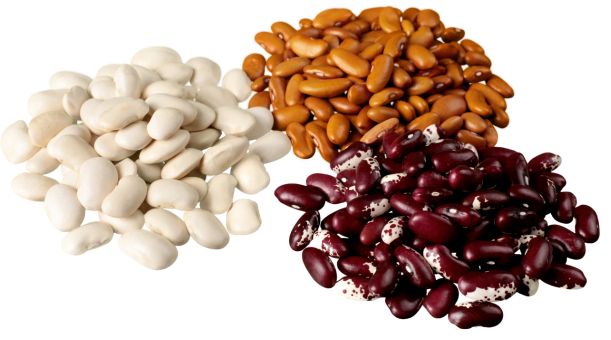
Here are some potential risks associated with feeding grains to dogs:
- Some dogs may have allergies or sensitivities to certain grains, which can cause digestive upset, skin irritation, or other symptoms.
- Grains can be high in carbohydrates, which may not be suitable for all dogs, especially those with health issues such as diabetes or obesity.
- Some low-quality dog food brands may use grains as fillers, which can contribute to poor nutrition and even harm your dog’s health.
- Grains may contain anti-nutrients, such as phytic acid or lectins, which can interfere with the absorption of other nutrients and may cause digestive issues.
- Some dog food brands may include grains that have been processed or refined, which can reduce their nutritional value and may even be harmful to your dog’s health.
- Feeding too many grains or an unbalanced diet that relies heavily on grains may lead to nutritional deficiencies or imbalances over time.
Remember that the risks associated with feeding grains to dogs may vary depending on your dog’s individual needs and health status. It’s always a good idea to consult with your veterinarian before significantly changing your dog’s diet.
Should I consult my vet before adding grains to my dog’s food?
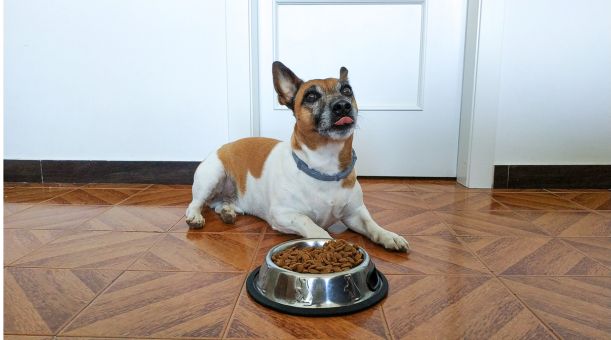
Yes, it’s always a good idea to consult with your veterinarian before making significant changes to your dog’s diet, including adding grains. Your veterinarian can guide the appropriate amount of grains for your dog’s needs and help you determine any potential risks or concerns.
In particular, if your dog has any underlying health conditions, such as diabetes or food allergies, your veterinarian may recommend a specific type or amount of grains appropriate for their health status. They can also help you choose the best grain-inclusive dog food or supplement.
Whole grains can provide many health benefits; they should be part of a balanced and nutritionally complete diet that meets your dog’s needs. Your veterinarian can help you develop a diet plan appropriate for your dog’s health status and help ensure that your dog is getting all the nutrients they need to thrive.
Can I add grains to my dog’s homemade food?
Yes, you can add grains to your dog’s homemade food as long as you do so in a balanced and appropriate way for your dog’s individual needs. Homemade dog food can be a great way to provide your dog with various nutrients and flavors, but it’s essential to ensure that their diet is complete and balanced.
When adding grains to your dog’s homemade food, start with a small amount and gradually increase the portion over several days to avoid digestive upset. You can also consult your veterinarian or a veterinary nutritionist to determine the appropriate amount and type of grains for your dog’s needs.
Remember that grains should not be the primary source of protein in your dog’s diet. Dogs are carnivores and require a diet high in protein, so you must include high-quality animal-based protein sources in your dog’s homemade food.
It’s also important to ensure that your homemade dog food is balanced regarding essential vitamins, minerals, and other nutrients. Consider consulting with a veterinary nutritionist to help ensure that your homemade dog food is nutritionally complete and meets your dog’s needs.
How can I tell if my dog is allergic to grains?
If your dog is allergic to grains, they may exhibit a variety of symptoms, including:
- Skin irritation or itching
- Redness or rash on the skin
- Digestive upset, such as vomiting or diarrhea
- Ear infections or excessive ear scratching
- Chronic licking or chewing of paws or other body parts
- Changes in appetite or weight
- Chronic or recurring infections, such as urinary tract infections or respiratory infections
However, these symptoms can also be caused by other factors, so it’s essential to work with your veterinarian to determine if your dog has a grain allergy or if there is another underlying issue.
If your veterinarian suspects a grain allergy, they may recommend an elimination diet or allergy testing to determine which specific grains your dog is allergic to. An elimination diet involves removing all grains from your dog’s diet and gradually reintroducing them one at a time to see which ones cause an allergic reaction.
Suppose your dog does have a grain allergy. In that case, your veterinarian may recommend a grain-free or limited-ingredient dog food that does not contain the specific grains that trigger their allergic reaction.
Conclusion
grains can be a nutritious and valuable addition to your dog’s diet, providing essential nutrients such as fiber, vitamins, and minerals. However, it’s essential to consult your veterinarian to determine the appropriate amount and type of grains for your dog’s needs.
While most dogs can tolerate grains without issue, some dogs may have allergies or sensitivities that can cause digestive upset or other symptoms. It’s important to watch for signs of a grain allergy and work with your veterinarian to determine if there is an underlying issue.
If you add grains to your dog’s diet, choose high-quality dog food or supplement that is balanced and nutritionally complete. Homemade dog food can be a great way to incorporate grains, but ensuring that the diet is balanced and appropriate for your dog’s needs is essential. Consulting with a veterinary nutritionist can help ensure your dog gets all the nutrients they need to thrive.

